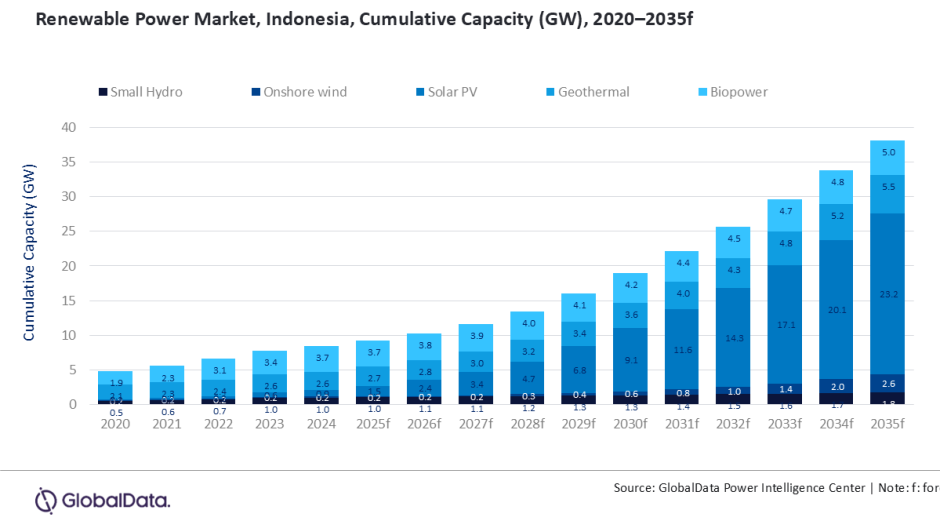Indonesia is making significant strides in its clean energy transition, while continuing to rely heavily on thermal generation to meet its electricity needs.
Supported by major investments in solar photovoltaic (PV), onshore wind, and geothermal energy, the Indonesia’s cumulative renewable power capacity is projected to reach 38.1GW by 2035, up from 8.4GW in 2024. This represents a compound annual growth rate (CAGR) of 14.7 percent, according to GlobalData.
Solar PV and onshore wind are the main drivers of Indonesia’s renewable growth. The expansion is supported by evolving policy and investment frameworks under the National Energy Policy (KEN), RUPTL 2025–2034, and Presidential Regulation 112/2022.
Solar PV and Wind Lead Renewable Expansion
Indonesia’s solar PV capacity is expected to surge from 0.9GW in 2024 to 23.2GW in 2035, fueled by floating and utility-scale solar projects and rooftop solar programs. The growth is underpinned by feed-in mechanisms and updated net-metering regulations. Onshore wind is also forecast to expand significantly, from 0.15GW to 2.6GW by 2035, driven by competitive tenders and hybrid renewable projects in Sulawesi and East Nusa Tenggara.
Geothermal energy is set for steady growth as well, increasing from 2.6GW to 5.5GW, leveraging Indonesia’s vast geothermal resources and strong fiscal support through the PT SMI Geothermal Fund.
Mohammed Ziauddin, Power Analyst at GlobalData, notes, “Indonesia’s renewable expansion is being catalyzed by national frameworks such as the Just Energy Transition Partnership (JETP), which targets 44 percent renewable electricity by 2030, alongside fiscal and investment incentives under RUPTL 2025–2034. Regulatory clarity under Presidential Regulation 112/2022, which limits new coal development and strengthens renewable integration, further supports this growth.”
Thermal Power Remains Key to Grid Stability
Despite the surge in renewables, Indonesia’s power system will remain heavily reliant on thermal generation through 2035. Domestic coal reserves, affordability considerations, and the role of gas in maintaining grid stability ensure thermal energy continues to play a critical role.
Coal-fired capacity is expected to rise from 55.6GW in 2024 to 61.4GW in 2035, while gas-fired capacity will increase from 29.1GW to 36GW, providing flexibility and backup for intermittent renewable sources. For Indonesia’s geographically dispersed, island-based grid system, thermal generation offers reliability and cost stability as renewable infrastructure and energy storage expand.
Indonesia’s power system is entering a dual-track phase, scaling renewables while retaining thermal stability. With solar PV and wind leading the growth, supported by geothermal development and grid modernization, the country is steadily building a more diversified and secure energy mix through 2035 and beyond.
Baburajan Kizhakedath

